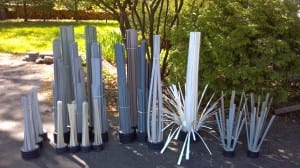Valley farmers protest heavy-handed measures to protect fish
More than 25 farmers from the Fraser Valley demonstrated outside the Department of Fisheries and Oceans (DFO) headquarters in downtown Vancouver Tuesday, saying their ability to farm is being hurt because endangered fish species have colonized ditches.
See the dozens of unique artificial fish habitat models, fish attractors and fish cover used at fishiding.com, the leader in proven science based, fish protection.
Farmers from Agassiz, Chillliwack and other parts of the Valley said fisheries officers are unreasonably restricting them from clearing or dredging ditches because they’ve been deemed fish habitat.
Ditches that aren’t kept clear can flood farmland, raise the water table and degrade the ability to grow crops or graze cattle, farmers said.
“I’m concerned for my farmland,” said Agassiz dairy farmer Gary Wikkerink, adding the allotted time each fall to conduct work in fish streams is too short.
Protesters brought two calves to the protest Tuesday to emphasize their point.
“It’s caused a lot of concern in the Agassiz area,” said Canadian Taxpayers’ Federation B.C. director Jordan Bateman, who organized the protest on behalf of farmers.
He said they want consistent enforcement of Fisheries Act rules that require setbacks and protection of fish-bearing streams.
“Fisheries officers seem to have a lot of discretion in how they interpret it,” he said. “That really bothers them.”
Bateman said farmers want to influence the outcome of Ottawa’s expected rewrite of the Fisheries Act, which environmental groups fear will seriously weaken fish habitat safeguards.
“It’s coming down to the usual battle between big business and environmental values,” he said. “Nobody is looking at how it affects small farm property owners.”
The Canadian Taxpayers’ Federation has launched a petition calling for Fisheries Act reform to support farmers.
Farmers aren’t the only ones affected.
One Agassiz home owner said a new 30-metre construction setback from a creek that runs through his land means he would not have space to rebuild if his house ever burns down.
“If they get the setback they want, it makes the my value of my place disappear,” Alan Callander said. “It makes it worthless.”
Wilderness Committee policy director Gwen Barlee said farmers may have some legitimate concerns over fishery issues.
“But we don’t want to be rolling back environmental standards,” she said. “If we can’t protect fish habitat, there’s no way to protect fish.”
Ecojustice staff scientist Susan Pinkus said recovery strategies launched by the federal fisheries department to protect two endangered species found in small Valley streams – the Salish sucker and the Nooksack dace – may have angered farmers, because the department mishandled communications with those affected.
She said only one per cent of the critical habitat of the Salish sucker is in ditches, although some streams also run through farms, triggering large setbacks.
Fisheries and Oceans Canada officials could not be reached for comment.
– files from Jeff Nagel




 The new box culvert and open channel to Long Island Sound, which restored fish passage and tidal flows to the salt marsh. Volunteers installed the dune grass plantings.
The new box culvert and open channel to Long Island Sound, which restored fish passage and tidal flows to the salt marsh. Volunteers installed the dune grass plantings. The small alewife species of herring swimming up the newly opened channel to spawn in Bride Lake.
The small alewife species of herring swimming up the newly opened channel to spawn in Bride Lake.


